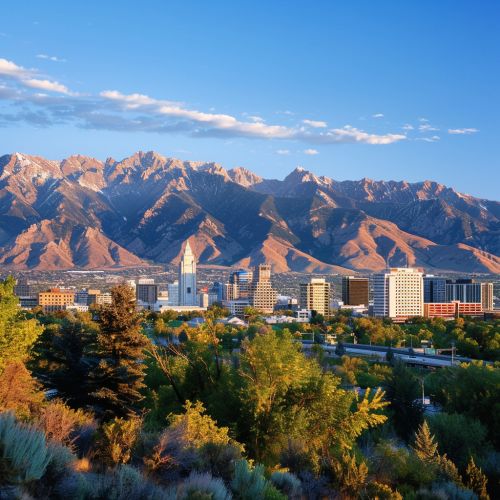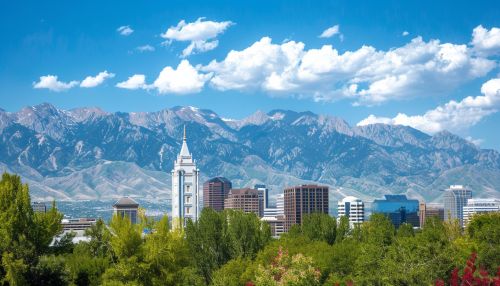History of Salt Lake City
Early History and Founding
Salt Lake City, the capital and most populous city of the state of Utah, was founded on July 24, 1847, by a group of Mormon pioneers led by Brigham Young. These pioneers were members of the Church of Jesus Christ of Latter-day Saints (LDS Church) who were seeking a new home where they could practice their religion without persecution. The area was originally inhabited by the Shoshone, Ute, and Paiute tribes.
Upon arrival in the Salt Lake Valley, Brigham Young is said to have declared, "This is the place," indicating that the valley would be their new home. The settlers immediately began building irrigation systems to water the arid land, which was crucial for their survival and the establishment of a sustainable community.
19th Century Development
Early Settlement
The early settlers faced numerous challenges, including harsh winters, limited resources, and conflicts with indigenous tribes. Despite these difficulties, the community grew rapidly. The construction of the Salt Lake Temple began in 1853 and was completed in 1893, becoming a central symbol of the city and the LDS Church.
Economic Growth
The discovery of precious metals in the nearby mountains in the late 19th century spurred economic growth. Mining operations for silver, gold, and lead attracted a diverse population, including non-Mormon settlers. This influx of people and capital helped transform Salt Lake City from a religious enclave into a bustling urban center.
Transcontinental Railroad
The completion of the First Transcontinental Railroad in 1869 was a pivotal moment for Salt Lake City. The railroad connected the city to the rest of the United States, facilitating trade and the movement of people. This connectivity accelerated the city's growth and integration into the national economy.
20th Century Expansion
Early 20th Century
In the early 20th century, Salt Lake City continued to grow and modernize. The establishment of various industries, including manufacturing and banking, diversified the city's economy. The construction of infrastructure, such as roads and public buildings, further supported this growth.
Great Depression and World War II
The Great Depression of the 1930s had a significant impact on Salt Lake City, as it did on the rest of the country. However, the city benefited from New Deal programs, which funded public works projects and provided employment. During World War II, the city's economy was bolstered by the establishment of military installations and defense-related industries.
Post-War Boom
The post-war period saw a population boom and suburban expansion. The construction of the Interstate Highway System in the 1950s and 1960s improved accessibility and spurred further growth. The city also became a center for higher education and research, with institutions like the University of Utah playing a significant role.


Late 20th Century to Present
Economic Diversification
In the latter half of the 20th century, Salt Lake City diversified its economy beyond mining and agriculture. The city became a hub for technology, healthcare, and finance. The establishment of the Salt Lake City International Airport further enhanced its status as a regional economic center.
2002 Winter Olympics
A major milestone in the city's history was hosting the 2002 Winter Olympics. This event brought international attention to Salt Lake City and led to significant investments in infrastructure and tourism. The legacy of the Olympics can still be seen in the city's sports facilities and increased global profile.
Modern Challenges and Developments
In recent years, Salt Lake City has faced challenges such as air quality issues, housing affordability, and rapid population growth. The city has also been at the forefront of social and political movements, reflecting its diverse and evolving population.
Cultural and Social Aspects
Religious Influence
The LDS Church has played a central role in the cultural and social life of Salt Lake City. The city's layout, with the Temple Square at its center, reflects the importance of the church. However, the city is also home to a growing number of people from different religious and cultural backgrounds.
Arts and Education
Salt Lake City has a vibrant arts scene, with numerous theaters, galleries, and music venues. The Utah Symphony, Ballet West, and the Sundance Film Festival are notable cultural institutions. The city is also a center for education, with several universities and colleges contributing to its intellectual and cultural life.
Demographics
The city's population has become increasingly diverse over the years. While it was once predominantly Mormon, today it includes a mix of ethnicities, religions, and cultures. This diversity is reflected in the city's neighborhoods, schools, and public life.
See Also
- Brigham Young
- Mormon Pioneer
- Salt Lake Temple
- First Transcontinental Railroad
- Great Depression
- 2002 Winter Olympics
- University of Utah
- Utah Symphony
- Sundance Film Festival
